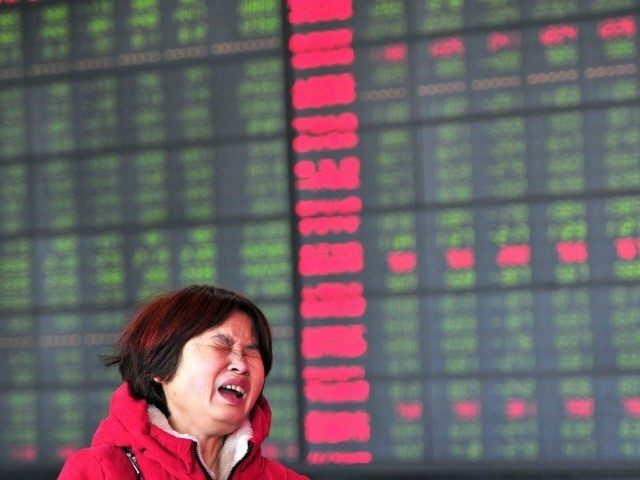Lombard Street Research (LSR) has reported that China’s “real” (after-inflation) GDP actually fell -0.2% for the quarter ending March 2015. Despite the official government claim of +1.3 percent growth for the quarter and +7 percent annualized growth. China’s quarterly performance was the worst showing since the Global Financial Crisis as, “real” domestic demand suffered a historic collapse.
LSR’s Diana Choyleva has been the best Western economist at untangling China’s less-than-authentic economic statistics. She reveals that after peaking in 2014 at +2 percent on real domestic demand growth, China has collapsed by over 4 percent and to a -2.1 percent. Choyleva says this is the first negative performance observed since LSR began recasting China’s quarterly economic reports in 2004.
China’s leadership seems determined to absorb the pain of dismal growth in the export and housing sector as the nation reforms its economy in hopes of achieving a more sustainable expansion through growth in domestic consumer spending.
But LSR believes pulling off such a massive rebalancing will be a huge challenge, given the extent of past stimulus excesses. China’s 2014 gross domestic investment rate as a percentage of its GDP was a gargantuan 47.7 percent. That compares to 31.9 percent average for all of the developing countries and 19.8 percent for the United States.
Despite massive investment in new manufacturing facilities and housing, the Chinese economy has consistently contracted from a “real” annual GDP growth rate peak of 20 percent in 2010. China’s officially published data showed “real” GDP rose by 1.3 percent in the first quarter and 7 percent in the last 12 months. LSR comments that “By Chinese standards this is a clear admission of much weaker growth momentum.”
Communist China’s leaders claim they have made a conscious policy choice to go for the type of “creative destruction” associated with pure capitalist economies. That would mean that China plans to let uncompetitive state-owned-enterprises (SOE) default and be liquidated, rather than continue to protect employment by bailing out companies with new bank loans.
When China was first seeking to reform its banks and take them public in 1998 as part of an effort to modernize the financial system, distressed assets were the equivalent of about 20 percent of the combined loan totals for China’s “Big Four” banks, or 18 percent of China’s entire gross domestic product, according to a report by the 2003 Bank for International Settlements.
The only reason China did not suffer an enormous financial crash at the time was that its entry into the World Trade Organization launched the spectacular international out-sourcing boom. That is why China’s economy today is over 10 times larger than in 1998.
Chinese banks’ official non-performing-loan ratio is now reported at less than 1 percent of assets, according to the China Banking Regulatory Commission. That compares to the U.S. ratio of non-performing loans to total assets at 3.9 percent.
Despite Chinese authorities’ efforts to stimulate bank lending, monetary conditions in China remain tight as “broad money” growth continues to decelerate. The culprits are massive capital outflows that reached historic highs of $91.2 billion last year and “seem to have persisted.” The amount of money escaping from the Chinese mainland explains why Japan surpassed China as largest holder of U.S. debt this week.
LSR notesthat weaker growth has decimated Chinese business profits, which fell 11 percent in the three months to February, compared with the prior three months. Mining profits plunged 50 percent and manufacturing profits dropped by 4 percent. Falling profits and no rise in unemployment means a substantial chunk of China bank loans are in default and are being rolled over without repaying interest or principal.
Corporate bank deposits over the last three years have fallen as a share of GDP by about five percentage points, but corporate debt as a share of GDP has risen by over 20 percent. That seems to confirm that most bank loans have been used for prolonging existing debt, rather than for investments in new productive activities.
LSR estimates that with uncompetitive exporters and collapsing domestic demand, the Chinese yuan currency is about 20 percent overvalued. To become more trade competitive, China could follow Japan and devalue its yen exchange rate by 30%, or follow the euro zone and devalue its currency by 15%. But Chinese companies have raised about $203 billion in US dollar bonds. That means a devaluation of the yuan would make paying off those US dollar bonds much more difficult.
Chinese President Xi Jinping is using an anti-corruption drive that has seen the arrest of 250,000 government officials and has purged top communist party big-wigs. He likes to say: “If you want to be rich, do not be a government official. If you want to be a government official, do not want to be rich.”
LSR sees this effort as building credibility with the Chinese public to support the radical transition that China faces from an export-led to a consumer-led economy over the next decade. But as the pain of change intensifies, LSR suggests that China could still suffer a spectacular financial crash.

COMMENTS
Please let us know if you're having issues with commenting.